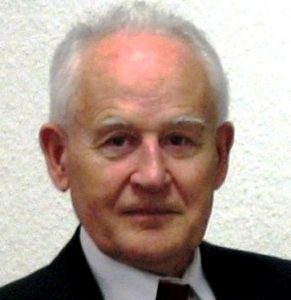László Perneczky
Between 1961 and 1963, he worked at the Northern Transdanubian Electricity Supply Company (ÉDÁSZ): for one and a half years he was a caloric plant manager at the Győr I Power Plant.
In 1963, he was transferred to the Budapest Electric Power Industry Research Institute (VEIKI). He worked on the development of a digital model of power plant rotary air heaters, which was used for development tasks. He led research in the fields of vibration image testing of domestic steam turbines, automatic starting of steam turbines and the development of the TURBOSTART target device for this purpose.
Meanwhile, in 1966, as part of his electrical engineering diploma design internship at the Electronic Measuring Instruments Factory (EMG), he was able to get involved in the final phase of the development of the EMG 830 computer under the leadership of Árpád Klatsmányi.
In 1972, he defended his doctoral dissertation on the topic of automatic turbine starting (including the first process control subroutines - written in the domestically developed SIMPLE assembler in June 1966).
From the end of 1973, he became a member of the Thermohydraulics Laboratory at the Atomic Energy Research Institute (AEKI) of the Central Physics Research Institute (KFKI) of the Hungarian Academy of Sciences, where his research area included safety analyses of pressurized water nuclear reactors - along with theoretical and experimental, as well as digital simulation, investigations of primary coolant circuits.
In 1979-1980, he spent 15 months at the Kernforschungszentrum in Karlsruhe on a scholarship from the International Atomic Energy Agency (IAEA) learning about the RELAP5 and TRAC American reactor safety system codes.
After returning home, he played a significant role in preparing the computer simulation safety analyses required for the operation of the reactors of the Paks Nuclear Power Plant (PAV) in accordance with Western standards, creating the detailed database and digital model of the analyses required for the RELAP5 analyses of the VVER-440 reactor. He also participated in international collaborations (VVER-440: IAEA projects, Belgian, Finnish, German Democratic Republic (GDR), Slovak institutes, and VVER-1000: Kurchatov Institute in Moscow).
He retired in 1998, but worked for another 14 years.
His awards: Public Culture Award (KFKI, 1979); Lajos Jánossy Award (KFKI, 1989); Engineers for Peace and Universal Culture Memorial Plaque (Debrecen Academic Committee, 1996); Ferenc Ronkay Energy Engineering Award (Hungarian Chamber of Engineers, 2011).
His hobby is symphony orchestra activities (he plays the violin and viola):
- He was the youth secretary of the Technical University Orchestra between 1958-1961.
- He was a member of the ÉDOSZ Liszt Ferenc Orchestra (with interruptions) between 1964-1994.
- Between 1987 and 2014, he was a member of the German nuclear technicians' amateur orchestra, the Camerata Nucleare - the only Hungarian, commuting from Budapest (85 concerts in 5 countries, six CD recordings).
- Since 2004, he has been the chairman of the board of trustees of the “Foundation for Concert Music Orchestra”.
Created: 2022.01.18. 18:31
Last modified: 2022.11.16. 21:17

